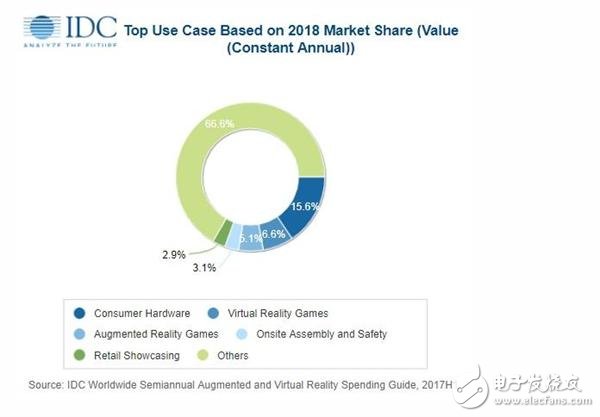According to IDC, AR/VR will be expected to awaken in 2018, which will cost US$17.8 billion in consumption. The consumption sector is the most important consumer expenditure. From product design to retail sales, AR/VR has great potential. The game has become a major AR/VR use case for consumers, with retail being the main consumer segment, followed by the manufacturing and construction industries.
According to International Data Corporation (IDC), global spending on augmented reality and virtual reality (AR/VR) will reach $17.8 billion in 2018, which is expected to increase by nearly 95% compared to $9.1 billion this year. Recent updates to IDC's global semi-annual augmented reality and virtual reality spending guidelines show that global spending on AR/VR products and services will continue to grow at similar rates for the remainder of 2017-2021, with a five-year compound annual growth. The rate reached 98.8%.
“Virtual reality will continue to drive consumer spending growth in the next 12-18 months, as both consumer and business use cases are gaining momentum. Currently, huge demand from companies, from product design to retail sales, to employee training, is huge. The potential.†At the same time, the augmented reality market will bring more modest spending in the short term – mobile devices on smartphones and tablets may attract Consumers are more concerned, and head-mounted displays will be sold primarily to commercial use cases."
The consumer sector will continue to be the single largest source of AR/VR products and services, with global spending expected to reach $6.8 billion by 2018. Nearly three-quarters of this will be used for virtual reality hardware and software, while AR spending will be dominated by software purchases. Throughout the forecast period, the game will become the primary AR/VR use case for consumers. The five-year compound annual growth rate of consumer AR/VR spending is 45.2%, and the total expenditure will exceed $20 billion by 2021.
In contrast, in 2018, the business sector will account for more than 60% of AR/VR spending, and by 2021, this number will grow to more than 85% of the global total. It is expected that the five business sectors will experience three-digit expenditure growth throughout the forecast, with a five-year compound annual growth rate of 156.7% dominated by the public sector. The largest business area in 2018 will be distribution and services ($4.1 billion), led by the retail, transportation and professional services industries. The second largest area will be manufacturing and resources ($3.2 billion), balancing spending in manufacturing, construction and discrete manufacturing. The retail industry will be the largest consumer of AR/VR in 2018, followed by the manufacturing and construction industries.
Business use cases will vary by field and industry. In the distribution and service sectors, retail display and online retail will be the two largest use cases, spending more than $950 million in 2018. The online retail industry will also experience abnormal consumption growth with a compound annual growth rate of 225% over a five-year period. On-site assembly and safety production, process manufacturing training and industrial maintenance will be the largest use cases in the manufacturing and resource industries. In the public domain, infrastructure maintenance and government training will be the two biggest use cases in 2018.

“Commercial entities are ready to embrace virtual reality, customer-facing and internal use cases,†said Marcus Torchia, research director for customer insight and analysis at IDC. “There are many opportunities to develop commercial-grade hardware and applications to meet the needs of these industries. At the same time, mobile-based AR is likely to get most of the attention in the short term, and many companies are already experimenting with AR applications and services. Some of them will be useful, but many are in vain, but in the next 12 In -18 months, we should start to see developers start to grasp the potential of AR."
Geographically, the US will be the largest place for AR/VR spending ($6.4 billion) in 2018, followed by Asia/Pacific (excluding Japan) ($5.1 billion) and Europe, Middle East and Africa ($3 billion). ). The United States will experience some accelerated growth during the forecast period and is expected to peak in 2020. At the same time, the Asia-Pacific region outside Japan will see a slowdown in its spending growth at the end of the forecast. The five-year compound annual growth rate of these two regions will exceed 100%, followed by Canada (composite annual growth rate of 139.9%) and Central and Eastern Europe (composite annual growth rate of 113.5%), becoming the fastest growing region. The slowest growing region in Asia will be Japan, where the compound annual growth rate is only 36.5%.
The Global Semi-Augmented Reality and Virtual Reality Spending Guide examines the opportunities for AR/VR and provides insight into how this fast-growing market and how the market will evolve over the next five years. Revenue data is available for 8 regions, 12 industries, 26 use cases and 11 technology categories. Unlike other research in the industry, this comprehensive spending guide is designed to help IT decision makers clearly understand the specific scope and direction of current and future virtual reality/virtual reality spending.
Lead Acid Solar Battery,2V Sealed Lead Acid Battery,Sealed Lead Acid Battery 12V 150Ah,Lead Acid Battery For Solar
Henan Xintaihang Power Source Co.,Ltd , https://www.taihangbattery.com
